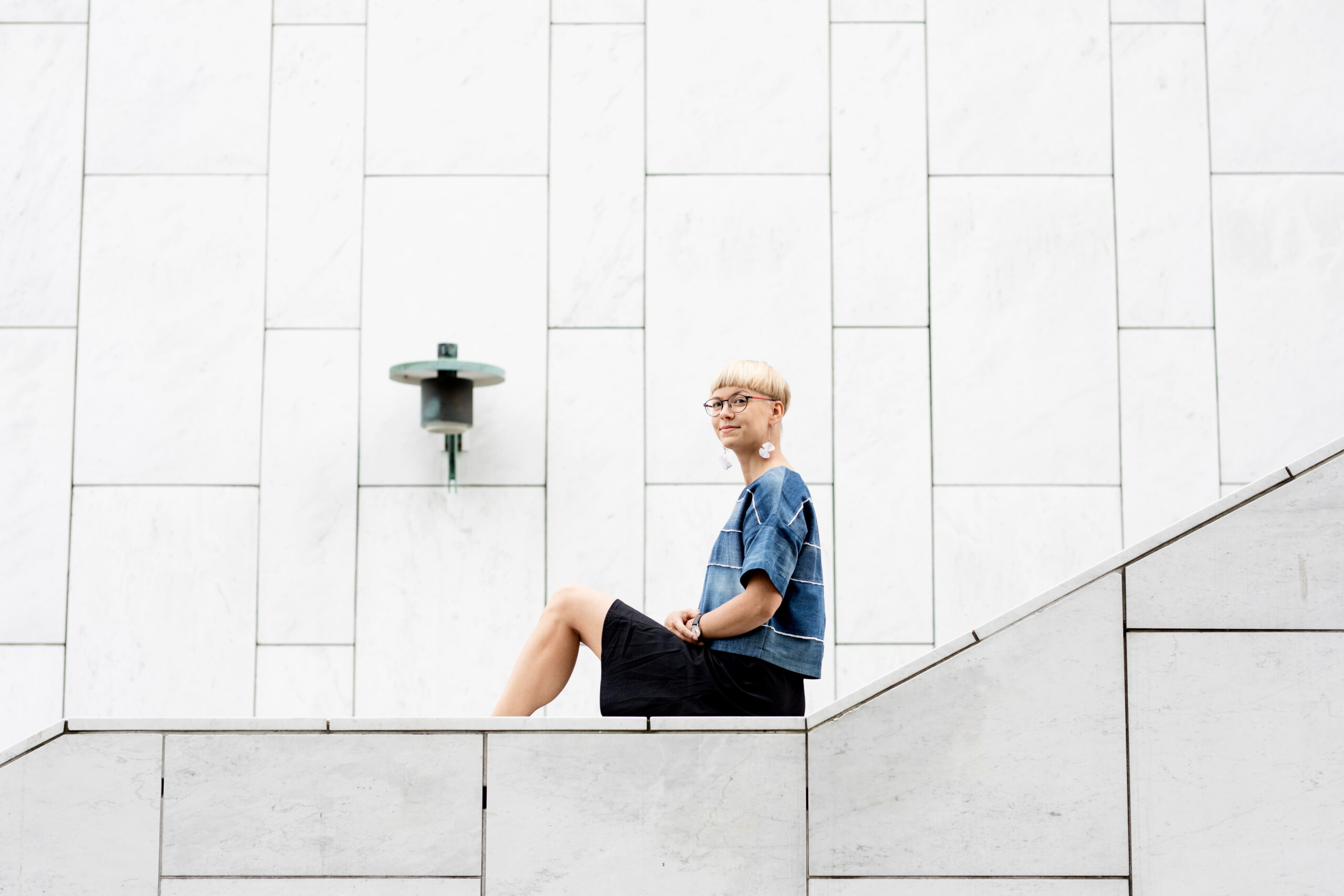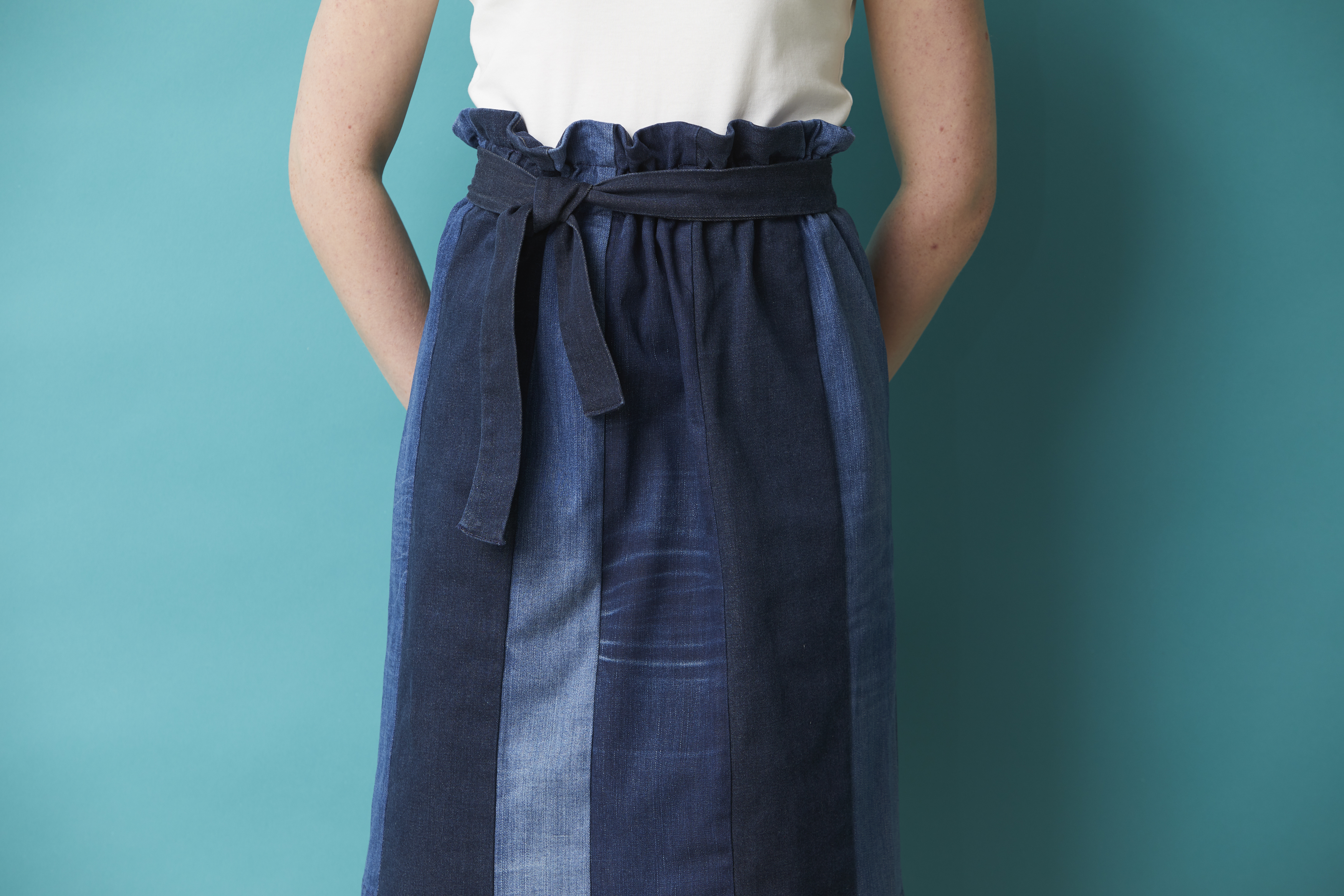Pumpkin-farmer/designer Elina Korri fell for old denim – and made it her business

Elina uses recycled denim to create sculptural clothing and holds workshops on sustainable fashion. With Helmi Honkanen she discusses the hardships of the industry and the meaning of love.
“Hi, sorry, I need to make some inquiries. They’re saying my child didn’t turn up for her violin lesson.”
She exchanges a few messages with the Grandfather. Then smiles.
“We’ll, they’ll find her.”
It’s a hot afternoon in August; one’s shirt clings to one’s back. But not Elina Korri’s shirt. She’s wearing one from her own MEA brand featuring some beautifully worn-out denim. Her mission is clear: to provide an alternative to cheap fashion.
Elina wants to create clothing we are able to love for a long time.
Her platinum blond hair swings to the side as she looks you straight in the eye. Her gaze is curious. Elina is one of those like-meeting-an-old-friend types, sitting under the golden lamps designed by Aalto in the lobby of the Finlandia Hall. She grabs a cookie to take a bite.
“I haven’t been here since I was a teenager. We used do choir practice out there in the yard.”
As a designer she seems annoyed how rarely people consider the dark side of the clothing industry.
“It’s too easy to think we live in a world of unlimited resources and time. Of course it’s not true.”
Because this is a serious matter, and because in Elina’s opinion the debate is just getting started, she likes to talk about the topic and lead workshops where participants get to make accessories. Over the handiwork it’s easy to talk without making the participants feel like they are listening to the Sunday sermon. Korri doesn’t want to provoke a sense of guilt – inspiration is a much more fertile ground to work on.
Know your numbers
Elina fell in love with denim while in exchange in Scotland. The relationship turned serious very quickly.
A piece of clothing created as an exercise had a voice of its own, and time added more layers on it. The fabric became alive.
“I thought to myself that one day I’ll return to these items.”

In the hands of the designer the classic material turns into delightful graphical garments, such as a T-shirt that matches both Grandma’s rose-patterned coffee set and a party with an unpredictable dress code.
Her bubbly bearing shifts into serious when she starts to talk about the business side of things.
“Sure this is a difficult and truly unscrupulous business. People have no idea about what clothes can cost, what they cost to make, and overall, what is a good piece of clothing.”
The making needs to include certain seriality, otherwise there is not enough business. One fabulous brainchild every now and then is not enough to bring home the bread.
“In the beginning you may think you make killer products that everyone will buy just like that, but really, it can be very hard.”

Your passion for fashion will not cut the mustard. You need sales. You need branding. You need to understand pricing. All of these have been learned over time and by making. Elina thinks school did not sufficiently train for the whole.
“I think we had, like, one course of business skills.”
Wise pumpkins
“Hey, this is not as good as in Orivesi!” Elina yelps, her large earrings jolting.
She has just taken a sip of Helsinki’s tap water. “Well, it’s much better than in Turku,” she retorts.
The mind of a designer is in constant motion. The top keeps spinning, she tends to say.
“Often the other person is left clueless as my mind jumps from one thing to another.”
However, a bubbly brain is indispensable in brainstorming. A new idea may originate with a pattern on a manhole cover or at home with the “unusual rhythm” of knives and forks.
The designer’s mind has learned to settle, too, during recent years. Because of her kids. They teach to be patient and merciful towards oneself.
“Nowadays it’s okay to have a shitty day. Before it was much harder.”
Elina comes to think that in addition to kids, pumpkins, too, carry along deep wisdom. The fruit rooted in her yard has gone through a process: sowing the seed, growing up, harvesting.
The lesson learned is that not all is plug-and-play and that’s okay. An idea born in the morning doesn’t have to be top of the line in the afternoon.
“Do you love it?”
“I didn’t dream to be Jacques Cousteau on a coral reef in Australia but just to admire Finnish perch,” Elina explains her interest in diving, gesturing to make a point.
The underwater world, swimming, and nature in general have always kindled her spirits. In secondary school she thought a biologist would be a sufficiently grown-up profession, smarter than being an artist. The doors of the university did not open, however, not even an inch. Not after the third attempt either. While visiting a handicrafts market she finally saw the light.
“I saw wonderful things and super-skillful people. I thought to myself I’m going to do the same thing.”
It was a liberating revelation.
In between her studies Elina worked for the summer in a workwear company in London, and this left its mark on her: limpidity, production quality and functionality are all present in her own design.
She needs to hurry to a photo session against the marble wallscape designed by Aalto. Preparing to exit I grab my new, breathtakingly pink Nike jacket from the bench. I ask Elina if I’m going to burn in hell for making such an unethical choice. She laughs.
“Well, do you love it?”
“YES!”
“Then I say you won’t burn for it.”

Her phone beeps. It’s good news: the violin child that was missing has been found.
The admirers
-
Saija Lehtonen, who was interviewed for this series before, said she admires Elina Korri for her fashion activism and unique, personal idiom.
-
Elina says she admires Susanna and Tobias Feuerbacher of the Viilu brand. Their way of working is delightful, and they produce work of superb quality.